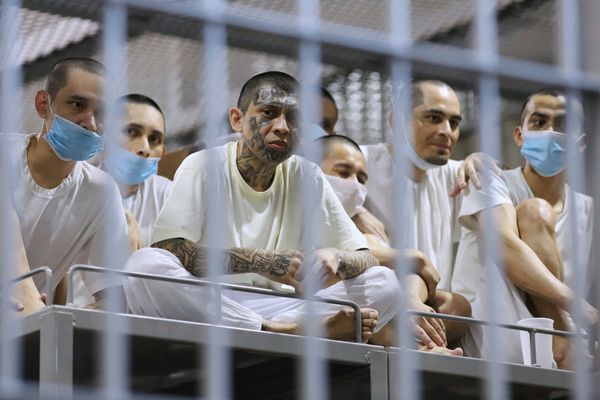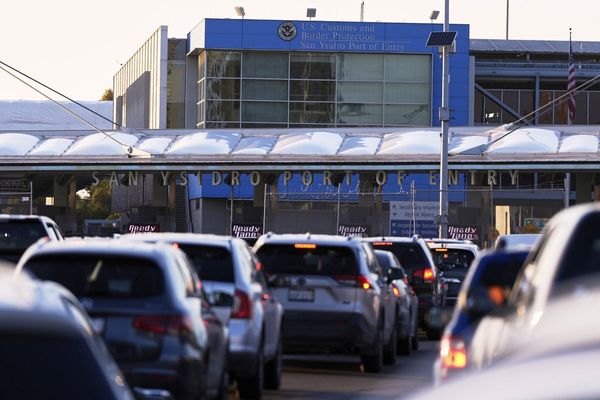
Time has been kind to Good Night, and Good Luck, George Clooney’s sincere dramatization of the broadcaster Edward R Murrow’s on-air tangles with Senator Joseph McCarthy in the 1950s. Sleek, slim and reverent, the 2005 film recalled a time of both cultural panic and promise, before American attention splintered and television’s road forked toward cable news. In its own era, the movie played in implicit contrast to mainstream media’s failure to interrogate the Bush administration’s dubious justifications for the Iraq war. In 2025, well … now, as in 1953, the lies run rampant. But in Clooney’s stark black-and-white drama, truth prevails.
Wouldn’t that be nice. The ongoing lurch away from due process casts both a haunting pall and a self-congratulatory glow over New York’s Winter Garden Theatre, where Clooney leads a proficient, if stiff, Broadway adaptation of his directorial debut. The 63-year-old actor, who originally played Murrow’s comparatively warm producing partner Fred Friendly, steps into the shoes of the hardbitten broadcaster for his Broadway debut with a palpable sense of purpose. The show, one of a handful of starry, expensive productions this spring, at least has the argument of pressing relevance for exorbitant prices. The past week’s wave of government deportations and detentions, for “ties” to “terrorist groups” without evidence or trial, uncannily echo the McCarthy hearings that falsely accused government employees of colluding with the Communist party.
That’s coincidental timing, of course, though Clooney and his longtime creative partner Grant Heslov have clearly altered their original script with an eye for the current climate, in ways ranging from natural to forced (a new line about how “all the reasonable people” went off to Europe and “left us behind” played to cheers in Manhattan). From the minute Clooney steps on stage as the celebrated war correspondent with authoritative bearing, the production resounds with pious reverence, the preponderance of Good History.
Like the film, the play, directed by David Cromer, begins a few years after its main action – in 1958, when Murrow accepts an award with a speech on the promise and perils of television, that nascent so-called idiot box. The occasion recalls the achievement that cost Murrow the primetime slot for his pioneering news program See It Now: repeated exposés of McCarthy’s fear-mongering that directly threatened the politician’s narrative of pressing national threat and CBS sponsors’ stomach for controversy. Good Night, and Good Luck largely stays faithful to its original material, conveying the oppressiveness of McCarthyism through a series of real-time broadcasts and staff meetings with Friendly (Glenn Fleshler), the wary CBS boss Bill Paley (Paul Gross), and the secretly married couple Joe and Shirley Wershba (Carter Hudson and an oddly stiff Ilana Glazer), whose subplot is even flimsier than in the film.
There’s an echo quality to the stage version – imitative, resonant but hollower than the original. That’s partly an issue of medium; the film flowed nimbly between whirring camera and tight closeups, the claustrophobia of McCarthy’s red panic reflected in the tightness of the picture, the biting of a tongue. The play necessarily relies on a macro view that, in comparison, feels rigid and affected. The designer Scott Pask turns the cavernous theater into one wall-less CBS office, buzzing with telephones and memos and staff shuffling film reels from room to room. After the disappointing grayness of the over-hyped Othello, I have to applaud an expensive Broadway play that invests in ample set design, including a live band for period-specific, lovely but unnecessary musical interludes. But what the staging delivers in newsroom cacophony, it loses in nuance, character and the entrancing mood of momentous defiance.
The show also makes an uneasy compromise on medium, betting too much on television. Extended sections of archival footage play on columns of TVs bookending the stage – a boon for history nerds like me, a bust for those annoyed by poor sound quality. Most confounding, Cromer stages each of Murrow’s verbatim broadcasts with Clooney facing perpendicular to the audience. We view his face as we’re used to: magnified and mediated by a screen. The roving projection (design by David Bengali) allows one to see, in chiaroscuro detail, the gravitas that Clooney did not possess 20 years ago – creased forehead, shadowed eyes, arresting scowl. But it keeps him at a curious, cold remove.
Still, there’s a cathartic pleasure to the proceedings, of watching a steely television broadcaster go toe-to-toe with a fear-mongering demagogue. Clooney, a Hollywood leading man better suited for the more avuncular Friendly, has a solid enough handle of Murrow’s intimidating aura – his flinty idealism, his constant smoking, his pattered, distinctly midcentury rhythm. Not quite as arresting as David Strathairn’s bristly film version, but thankfully more emotive than the real Murrow. And he delivers the gravitas when it counts, in a final postscript that returns to that 1958 address – a warning, like Eisenhower’s military industrial complex speech, but for TV.
It’s in the final minute that the show departs from its template with a multimedia gut punch, an admirable bid for sweeping commentary on television’s cultural history that is somehow broad, aching, chaotic, nostalgic, totally unspecific and effective all at once. Like the show, the method is scattershot but the message clear: Murrow may have won the battle, but television’s culture war had just begun.







